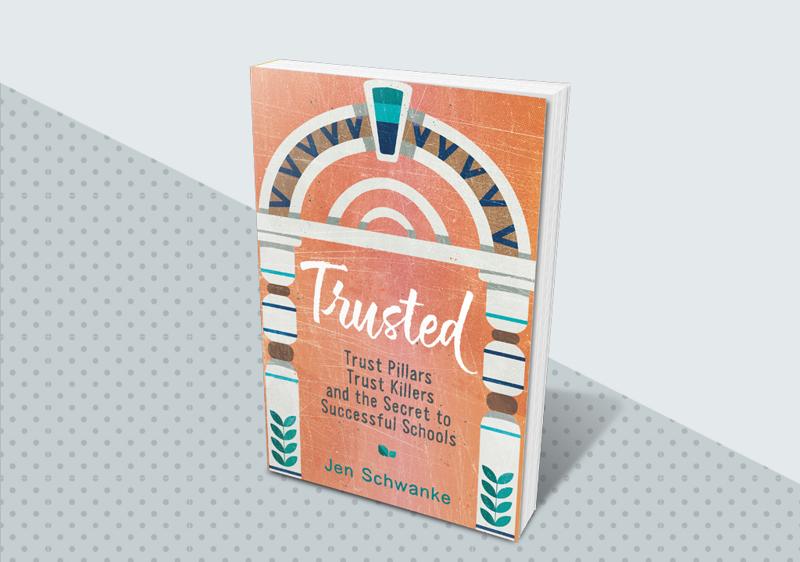I didn’t set out to write an entire book about trust. I didn’t think the concept of “trust” was all that complicated. I thought it was an individual value, not something that could be rooted in intentionality. It was like energy, or insight, or perspective—you either have it in a given situation, or you don’t. Besides, I thought, the important thing is that I am trustworthy to those around me. Right? And most educators are. Aren’t they?
An epiphany came when I was invited to lead a workshop in eastern Canada with about 100 principals, teachers, and district leaders. It was late July, the kind of blue, sunny summer day that stores itself in memory. We were working through an activity I call “C-CC,” in which principals make a T-chart of challenges and classify each as in their control (“C”) or as something they cannot control (“CC”). At one of the tables, the discussion evolved into a conversation about being trustworthy. One of the things we can control, they said, is whether others trust us. One principal wrote “trust” in the “control” column. “It’s not hard,” she shrugged. “Be honest, do hard things, check in with people. Be trustworthy.”
A school leader at the table—I’ll call him Robert—spoke up. “This doesn’t seem… fair,” he said. “Don’t you think trust is often a one-sided expectation for principals? We are expected to be trustworthy at all times. It’s a heavy burden.”
On my flight home, I thought about Robert and tried to zero in on what he was really asking. Was trust a one-sided expectation for principals? I didn’t think so. Perhaps it would help, I thought, to specifically define the things that both build and kill trust in schools. The sun was setting against wispy clouds, and in between gazes out the plane’s window, I sketched the word “Trust” in my travel notebook. Beneath each letter, almost unconsciously, I drew a tiny little pillar holding each letter. And beneath each pillar, I drew some crumbling rocks and shaky ground. I started adding words on each pillar—honest, kind, communicative—and between the surrounding rocks beneath—inconsistent, aloof, dismissive.
That sketch turned into a book.
How Trust Took Shape in Schools
Writing a book means you think about the topic for the better part of a year. It becomes all you do. You zero in on examples, on research, on outcomes. You strip back assumptions. As I wrote, I reflected on my own journey to trust and be trusted. I considered how trust can be a powerful force—one that builds strength when present and causes damage when absent. I considered our society’s current propensity to distrust educators. How had that happened, I wondered. When did educators enter an era where we need to prove ourselves as effective, well-intentioned, hard-working professionals?
To answer that question, I dug into historical research to follow the timeline of education in the past 400+ years. I saw a clear pattern: When people are struggling with societal unrest, they look immediately to find who should be held accountable. Who’s to blame? Who can’t be trusted? Politicians? Government? Teachers? Principals? Schools?
Yes. Schools. While schools have been—and continue to be—the roots of a community’s positive identity, it’s also true that society has often used schools as a mirror for its own failures.
While schools have been the roots of a community’s positive identity, society has often used schools as a mirror for its own failures.
Way back in the seventeenth century, the intent of schools—to teach religious values and basic reading, writing, and mathematics—was overseen by local residents. Schools fell under state oversight but retained local control. Early schools gave teachers autonomy but offered poor pay and little training.
To address these shortcomings, "principal teachers,” who were mostly men, were hired to monitor mostly female teachers. These early principals evaluated staff, administered exams, and managed discipline. With their role formalized, the modern K-12 education structure began to take shape.
The expectation? Teachers were to teach and principals were to be the enforcers of a school’s moral, ethical, and academic standard for a community. But this structure did not account for societal challenges, all which tested schools in big ways.
Over time, significant social tensions like wars, recessions, civil rights movements, labor unions, federal and state mandates, funding and tax burdens, and political instability heightened pressure and sparked controversy. Schools grappled with disparities in wealth and equity, inefficiencies in funding, school board oversight, and increased community expectations.
Sound familiar? Like huge threats to trust? Yes. Yes, it does.
Trust In Practice Today
Schools are uniquely vulnerable to scrutiny because a lot of people think they know how schools should work. After all, everyone went to school, right? They look to principals with their questions, seeking clarity and direction—which is why principals need to be trusted.
But, as Robert pointed out, it’s not a one-way street for school leaders. Building trust involves being both trustworthy and trust willing. Being trustworthy means others have faith in your leadership. Being trust willing means putting trust in others, allowing them to do their work without overreach or micromanagement.
Being trustworthy means others have faith in your leadership. Being trust willing means putting trust in others.
In my sketch, I eventually added a delineation between trust pillars—the behaviors and actions that support trust—and trust killers—the behaviors and actions that damage it. Here are a few examples of what that looks like in principals’ relationships with different members of the school community:
- With teachers, trust pillars include letting others lead, elevating other voices, and giving teachers opportunities. It means being reliable, knowledgeable, honest, and open. On the other hand, trust killers are inconsistency, lack of follow-through, favoritism, and actions that prioritize the principal's personal image over the collective success of the school community.
- With parents, trust pillars include empathy, honesty, staying focused on students, knowing and honoring each child's story, and communicating well and often. Trust killers are poor communication, compromised safety information, outward displays of frustration, over-complaining, and rigidity.
- With students, trust pillars include setting consistent expectations and consequences, giving a clear "why" for decisions, empowering student initiatives, being present and visible, knowing individual students, handling crises well, and supporting home-school partnerships. Trust killers are arbitrary or inconsistent discipline, refusing to explain decisions, or shutting down student-led initiatives.
In addition to building trust with others, principals must cultivate trust internally. We can’t be strong leaders unless we trust ourselves and lead with confidence and humility. In knowing our strengths and unique qualifications, and in being open to learning and growing, we become better equipped to lean into teamwork, slow down our decision making, manage conflict, acknowledge mistakes, and enjoy celebrations.
Choosing Trust, Daily
In writing the book, I recognized how precarious trust is. It’s tender. It’s a strong and critical component to relationships of any kind, yes, but it is always vulnerable to weakness. To keep it strong, we—school leaders—need to behave in such a way that shows we can be trusted and are willing to trust others. Whether or not they prove to be worth that trust is up to them. In fact, when I thought again about Robert’s question, I realized how much power lies in both being trustworthy and in being willing to trust others. That willingness is one thing we can control—and there is value in it: When we count on others to hold up their part of a trusting relationship, we are modeling shared leadership. We are building collective efficacy capabilities. We are making our schools a system of people—a team—rather than individuals. And in doing so, we become leaders. That’s how powerful trust is.
Trusted: Trust Pillars, Trust Killers, and the Secret to Successful Schools
A guide for new and experienced school leaders to build strong, trusting relationships with teachers, students, and parents.









